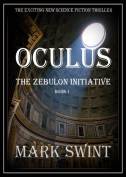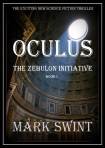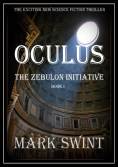By
Mark Swint
author of
OCULUS: The Zebulon Initiative
Isn’t it funny how the smallest things can sometimes lead to the biggest discoveries?
Take, for example, stars, or more specifically, starlight. For the common human experience stars are little more than twinkling points of light in an otherwise black sky. They are separated from us not only by unimaginably vast distances – distances so great that even the explanation of how far away they are fails to properly acquaint us with the true scale – but also by time. It’s true! Oddly, all of the points of light we see in the night sky represent completely different times of earthly existence. For example, when we look upon stars like Belletrix, Sirius, Betelgeuse, Vega, Antares or the Andromeda Galaxy, we actually see them as they were, not as they are. For example, we see Sirius as it was 8.6 years ago, Belletrix as it was 243 years ago, and Betelgeuse as it was 427 years ago. Antares shines light upon us that started its journey in 1402! Remarkably, if you can find the Andromeda Galaxy south of Cassiopeia you can look at light that left that galaxy 2 million years ago. More remarkable still, the Hubble telescope has taken photographs of galaxies whose light began its journey 13.5 BILLION years ago! Looking at a night sky that isn’t even representative of “real time” makes it even more amazing that these tiny points of light could have ever had any real, tangible effect on us and on our lives. Yet they say that truth is stranger than fiction and in the case of starlight they are right.
Early humans first perceived the regular east to west motion of the Sun and established the day as the first real measure of time. Each sunrise (or sunset depending on tribal preference) marked the beginning of a new day. The Moon crossed the night sky as a counterpoint to the Sun but it also did something very different as well. It not only moved east to west like the Sun but on each succeeding night it moved a little bit more to the east through the background of the star field. It also had phases , changing from full to waning gibbous and waning crescent to no moon at all, and then to waxing crescent and waxing gibbous until once again shining in the night sky as a full moon. This complete cycle took about 28 days and that repetitive cycle became the next demarcation of time, a lunar month. Closer examination of the Sun’s motion revealed that it too moved against the backdrop of the star field although at a much slower rate. It turned out that as the Sun moved against the background stars it also rose at a slightly different point on the horizon each day. In the summer the Sun rose well north of east ( for those in the Equatorial Band) and it slowly moved southward until the dead of winter when it rose well south of east. This north/south cycling repeated over and over and people noticed that the seasons followed suit. This period became a year and it lasted about 365 days. Early observers marked the northernmost and southernmost points of sunrise and these became the solstices. They also noticed that midway through the Sun’s trek from north to south and back again the daytime and the night time were of equal length so these points came to be known as the equinoxes. The four seasons were tied to these four points so we now have Spring commence on the Vernal equinox, Summer begins with the summer solstice, Fall starts at the autumnal equinox and Winter starts when the Sun hits the lowest point on the horizon, the winter solstice. In the early days of the Roman Empire (and in many other cultures as well) the New Year was celebrated at the beginning of spring. Have you ever wondered why September, October, November and December have names that begin with the prefixes for 7, 8, 9 and 10 even though the months are the 9th, 10th, 11th and 12th months? The vernal equinox came on the 15th of March on the Julian calendar so our 3rd month was the early Roman 1st month (although when Julius Caesar established his calendar he made January the first month, breaking with old tradition).
Once it was observed that the Sun moved against the star field it was decided to divide the star field along the ecliptic (the path followed by the Sun and Moon) into twelve portions. The constellations in those sections made up the Zodiac. When a person was said to be born under Pisces it meant that he or she was born during the time that the Sun was in the Star field in front of Pisces. Each of the signs of the Zodiac represented the time when the Sun was in that particular portion of the ecliptic. The men who studied this stuff were called astrologers and they held a very important place in society. As most all societies were agrarian it was crucially important to know when to plant and when to harvest. Tomato and melon growers, for example, dared not plant until the last frost of the year had fallen or else they would lose their whole crop. Likewise, harvesting had to be done before it got too cold. Astrologers were the people assigned to read the stars and make those determinations. The very survival of whole societies depended upon their accuracy.
Reading the stars took on a mystical aura and soon people began to ascribe all sorts of things to them. It was believed by many that the stars a person was born under were determinative of the course for that person’s life. So strongly held was this belief that the saying “you can’t change a person’s stars” was born along with the rather fatalistic determinism that followed. Many of us might remember a grandparent who would say “my stars’ as an exclamatory statement. It was also believed that stars controlled health and sickness and as pandemics swept Europe during the Middle Ages it was believed that sick people were under the ‘influence’ of the stars. The Italian word for influence is ‘influenza’ and we still use that word today, or its foreshortened term ‘Flu’.
What does this have to do with science and religion you may ask? Well, everything, as a matter of fact. You see, the early astrologers were often the theologians as well, or at least in the employ of the head cleric. This was appropriate as who better than men of God to study the heavens? However, things began to happen in the third and fourth centuries that would change the course of humankind forever, just not right away.
The emperor Constantine, the last Caesar of the Roman Empire fought tirelessly to quell the rising interest in Christianity until he finally concluded that it would be easier to adopt it as the official religion and transform the ‘Roman Empire’ into the ‘Holy Roman Empire’. In 325 A.D. he called all the clerics from around the Mediterranean to a conclave in Nicaea, a city in Turkey. There they were instructed to hash out their doctrinal differences and come out of the council with one unified, universal (or ‘Catholic’) doctrine. They were to make determinations and set doctrine on almost everything they could think of, including the heavens and the Sun, Moon and stars. They made decisions on whether there was empty space and just exactly what the Sun was. They decided that the stars were fixed in a shell that rotated around the earth. The Sun had its own shell as did the moon. They decided that the earth was the center of a geocentric universe and all things in the heavens revolved around our little planet. Now, this would have been OK if the council had issued a proclamation saying something to the effect that these new doctrines represented the best of their understanding to that point and that as further light and knowledge appeared doctrines would be reviewed and amended as appropriate. Instead, they declared the doctrines of the Nicaean Council to be ‘infallible’. Furthermore, they declared that anyone who disagreed with the doctrines would be guilty of ‘Heresy’, a sin punishable by death! Well, this worked OK for a little while but even from the beginning there were problems that unsettled the hearts of people of learning. Among the biggest of those problems were the stars the Greeks called the wandering stars or “Planetas”.
No one was really quite sure what the planets were. What was sure however was that the planets didn’t seem to follow any of the rules that all the other heavenly bodies followed. For example, the rest of the stars all moved in unison across the sky. Likewise the Sun and the Moon had their own predictable patterns. But the planets were a different story altogether. An individual planet like Mars, for instance, would move west to east for a while against the backdrop of the stars. It might then suddenly stop. Once it started moving again it might resume its eastward trek or it might just as easily begin moving east to west! It would follow this path for a time and then suddenly resume eastward movement. It might then disappear completely only to reappear some months later on the other side of the night sky! Jupiter and Saturn would likewise ‘wander’ around the sky although much more slowly while Venus verily zipped back and forth across the face of the Sun. All this was most confusing and no acceptable model could be made to explain it according to Catholic doctrine. It remained for many centuries a mystery.
Now let’s jump ahead 1100 years to Firenze, Toscana, or as we know it, Florence, in the Provence of Tuscany in Italy. It is the 1400s and a very powerful Florentine family known as the Medicis rule Tuscany. The Medicis were a banking family who, through intrigue and hard work, had become the bankers to the Vatican. This yielded them wealth and power beyond imagination. But the Medicis were an amazing family as well for they determined to spend some of their wealth serving as patrons for many of the brightest minds they could find. They patronized artists and architects, philosophers and poets. Among their more famous and productive patronages were people like Michelangelo, Botticelli, and Leonardo Da Vinci. Another of their men was a brilliant mathematician whom they hired to tutor (ultimately) multiple generations of Medici children. His name was Galileo Galilei.
Galileo was a man of wide a varied interest with an intellect sufficient to accommodate them all. His discoveries and inventions were numerous and his work lives on today. On the British two pound coin is inscribed around the edge “standing upon the shoulders of giants”. It is Sir Isaac Newton’s homage to Galileo and refers to his answer to the question “How have you managed to see so much farther than other men?” to which Newton replied “If I have seen farther than others it is only because I have stood upon the shoulders of giants!” referring particularly to Galileo.
Galileo is perhaps best known for two things, dropping two rocks of dissimilar size from the Leaning Tower of Pisa (his birthplace) and the invention of the telescope. It is this last item which brings us back to our tiny points of light that changed the world.
The telescope was a remarkable invention. It had the previously undreamt of ability to bring distant objects into full view. It could even reveal things unable to be made out with the naked eye. Galileo probably first used the new device to check out the sights of the surrounding Florentine environs. After scoping out the hot Italian ladies in the neighboring buildings (come on, you know he did!) he then turned his sights on even more heavenly bodies – the moon and the stars. The brightest star in the night sky was Jupiter, the largest planet in our solar system. (Though Jupiter is today referred to as a planet, in Galileo’s day planets were considered mysterious ‘oddly acting stars’). As he trained his telescope on Jupiter Galileo made a surprising discovery that forever changed the relationship between scientists and theologians and, more generally, between science and religion. He saw four tiny specks of light next to the giant planet. That’s all, just four tiny points of light. After a few weeks of observation and careful note taking it became obvious that the four little lights were in fact moons of Jupiter! And that, my friends, was earth shaking! That four previously unviewed sparkling points of light could change the world seems oddly disproportionate to their apparent significance but, like it or not, the world would never again be the same.
The Galilean moons, as the newly discovered objects came to be known, weren’t supposed to be there. They weren’t supposed to exist at all. The doctrine established by the Nicaean council had declared that all objects in the sky revolved around the earth and nothing else, yet here were four objects clearly and indisputably revolving – orbiting – another object in the sky! The implications were enormous and the entire geocentric (earth centered) theory of stellar mechanics – already hanging by a thread – was brought to the brink. Copernicus had already advocated an Heliocentric ‘Solar system’ in which the planets, including Earth, orbited the Sun. Galileo subscribed to this thinking and the discovery of the Galilean moons only reinforced that belief. In 1615 he was denounced for his beliefs before the Roman Inquisition. Though he was cleared of offenses at this time his ideas, published in 1632 in a supposedly fictional conversation called “Concerning the Two Chief World Systems” brought him back before the inquisition where he was found “vehemently suspect of heresy”. He could have been sentenced to death but by recanting his support for the heliocentric theory and through the intercession of the Medicis he was merely sentenced to house arrest for the remainder of his life.
The damage to the already uneasy relationship between the thinkers and the Church had been done and the rift was only to grow wider from this point on. Galileo’s moons were obviously real and easily seen by anyone who cared to gaze through the telescope. That the church would doggedly maintain a doctrinal disagreement with readily observable fact only heightened the suspicion held by some that the church was not, in fact, the sole and absolute repository for truth. This, coupled with the persecution of the Inquisition against any who dared think along lines other than those expressed by the church, created a cabal of intellectuals who began to rely on their own cleverness and discovery rather than the proclamations of the church. More damaging still to the church was the growing willingness of others to question other aspects of theological edict and doctrine. The coming forth of Guttenberg’s printing press and the accompanying availability of the written word to the huddled masses empowered people to begin their own self directed searches for truths and answers. Ultimately, growing discontent with the official church doctrines led to the Protestant Reformation.
The die had been cast and the grip of the Holy Roman Empire was quickly losing purchase. There was change in the air and a sense of empowerment that the people had never before known. People began to explore and question all aspects of their lives and the western world began to emerge from the long intellectual sleep we call the ‘Dark Ages’. The Renaissance had begun and the rate of discovery and progress it spawned are unrivaled in the annals of history.
To say that Galileo single handedly started the Renaissance would be incorrect. There had been a restless undercurrent of discontent which inspired men like Galileo to challenge the conventions common to the time. However, Galileo’s invention of the telescope and the ensuing discoveries of moons around another planet were the first tangible, ‘hard’ evidence that, as Shakespeare wrote, ‘There are more things under heaven, Horatio, than are dreamt of in man’s imagination.”
It’s hard to imagine that a few points of light could change the world – but it’s true.



